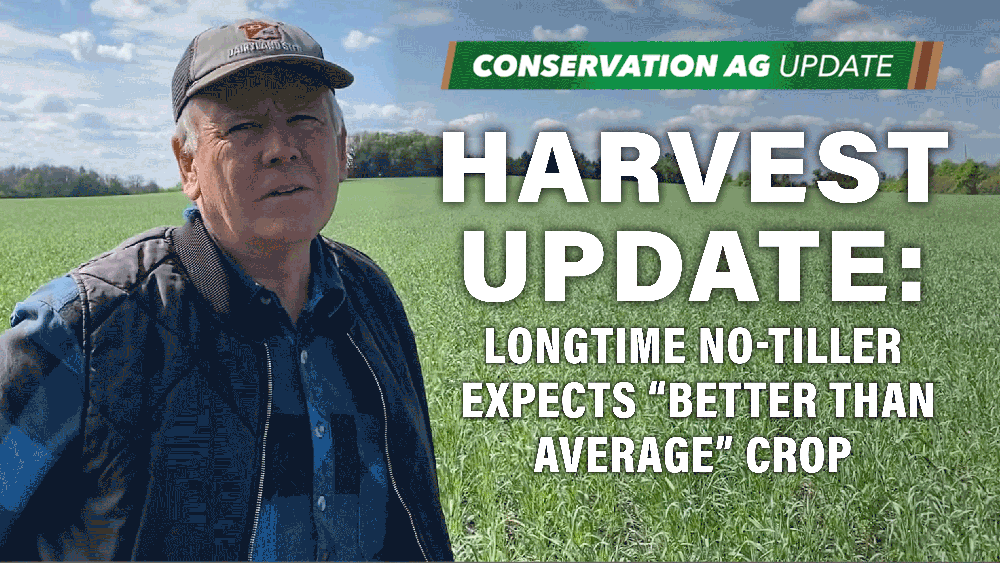On this episode of Conservation Ag Update, brought to you by CultivAce, Wisconsin no-tiller Tony Peirick checks in with an update on his crop as harvest season continues across the Corn Belt. Peirick explains why he’s expecting a “better than average” harvest even after an extremely dry summer.
Plus, we pay a visit to Mike Peterson for the Farmer Feature segment. The Minnesota no-tiller and strip-tiller shows off his unique equipment setup, which includes mounted nitrogen tanks on his tractor.
Also in the episode, assistant editor Mackane Vogel shares results from a new research study on the effects of cover crops on yield and weed control, Verdant Robotics showcases its new smart sprayer box, and more!
This episode of Conservation Ag Update is brought to you by CultivAce.
CultivAce is a West Coast manufacturer and distributor of a comprehensive line of foliar and starter fertilizers. CultivAce offers innovative solutions that drive agricultural crop yields and cultivate profitable outcomes.
With a relentless focus on delivering the highest quality foliar and starter fertilizers, we are committed to empowering growers with the tools they need to achieve remarkable results. CultivAce is built on two fundamental principles: products must be the highest quality, and they must make the grower money. If a product doesn’t meet these standards, CultivAce doesn’t manufacture it.
For more information go to CultivAcegrowth.com.
TRANSCRIPT
Jump to a section or scroll for the full episode...
- Harvest 2023: “Better Than Average” Crop for Longtime No-Tiller
- No-Tiller/Strip-Tiller Moves N Tanks to Tractor for More Flexibility
- Conventional vs. Regenerative Ag Research Study
- Ahead of the Curve: Verdant Robotics Smart Sprayer
- Photo of the Week: Massive Strip-Tilled Carrots
Harvest 2023: “Better Than Average” Crop for Longtime No-Tiller
Harvest season is officially underway! Overall, 23% of corn and soybeans have been harvested according to the latest USDA Crop Progress report. Question is, how did everything turn out after such a dry summer across most of the Corn Belt?
Let’s check in with longtime no-tiller Tony Peirick in Watertown, Wis., where only 5% of corn has been harvested. Tony’s expecting a better than average crop, despite getting no rain for almost 5 weeks after planting. He says the weather cooperated late in the summer and early fall, and his cover crops rallied in the home stretch, finally paying off after a disappointing start.
“This year being so dry, it (the cover crop) just kind of stayed there, and it wasn’t breaking down into the soil, and nutrients weren’t getting back to the corn. It was a little frustrating early on, but finishing out the season, it really made a big difference — the covers and no-till — because it really kept the corn green in August, and it (the corn) fed off the nutrients that were finally breaking down from the long, dry summer.
“We got a better crop than a lot of people expected right now, I’ve been hearing. There’s more corn and beans out there than we thought we were going to have. I think it will show up, too, in no-till and covers vs. full tillage. I think we’re going to see it this fall more — the benefits of no-till and covers — because we were able to at least keep more moisture in the soil during the hot spell.”
Tony will know more in the next couple weeks after a late harvest. The USDA reports 53% of corn, and 52% of soybeans are in good to excellent condition.
No-Tiller/Strip-Tiller Moves N Tanks to Tractor for More Flexibility
18% of corn is harvested in Minnesota, which is where we’re headed to catch up with Mike Peterson for this week’s Farmer Feature. Peterson no-tills soybeans and strip-tills corn across 800 acres in Northfield. And he’s doing something pretty unique with nitrogen tanks on his tractor. Check it out.
“We try not to get too much nitrogen in the zone early on to get that zone too hot. That led us into needing a liquid system and a way to split apply our nitrogen in season. That led us into mounting tanks onto our tractor. Behind me here is a new rendition this year. We made a little different nitrogen sidedress bar, moved the tanks from the bar itself onto the tractor. We had to come up with a way to work some sidedressing saddle tank mounts on our tractor while still being able to keep the front wheel assist tires at 120-inch spacing.
We enjoy that spacing for stability and our ability to get through wetter areas. It holds better on the hills, but there’s just no room for tanks. So, they had to be alongside us. With this system, too, it enables us to free up the toolbar. Now I can mount a companion unit that will be able to distribute cover crop seeds as we’re going down the field applying nutrients.”
Mike has a sprayer bar that he uses to terminate cover crops. It easily attaches to his tractor. But he still relies on a commercial applicator for primary weed control on his farm.
Conventional vs. Regenerative Ag Research Study
Jim Stute, an independent research agronomist and farmer member of the watershed protection committee of Racine County in Wisconsin, is helping to lead a long-term comparison of conventional tillage vs. no-till and cover crops. After just 1 year, the study still has a long way to go, but initially, Stute is seeing a 26.3 bushel per acre yield advantage with conventional. And most importantly, Stute says what he thinks they can do next year to shift those results.
“We found the answer in the fall after harvest when we’re characterizing our biomass yield. So in this trial, we’re looking at all the carbon inputs both above ground and also below ground. That means digging roots. So, we dug roots and what we have here is an image of roots.
This side from the conventional and then this side is regenerative. Now, there is a slight problem with this photograph. I moved the roots to get better lighting but I didn't move the scale so the scale would be up here. So, where we are seeing this cut off in the roots is somewhere between 5 and a half and 6 inches. Obviously we had compaction, in a layer there that prevented the roots from penetrating to get moisture and also nutrients.
And it’s a combination of the two and we can say that based on some of the diagnostic nitrogen testing that we did. So we did basil stock testing which is where after physiological maturity — so you’ve gotten all the yield you’re ever going to get. You take the bottom foot of the corn stalk just above the crown and then the foot beyond that. And you analyze it for nitrate nitrogen. You need to have nitrate nitrogen there because it’s mobile in the plant and until the plant shuts down, that nitrate is going up to the kernels to help fill the kernels in metabolism.
It’s a well calibrated test and when we look at our values we see that in conventional we were in a category that we would call sufficient. For the regenerative system, we were deficient so that tells us that we were starved for nutrients. And then when we do a postmortem on post-harvest soil profile nitrate — so this is nitrate that is left over from the previous season — and that’s a combination of what we applied for the crop as well as what the soil gave up in the form of ammonium — this is what’s left over.
And we see a 4o pound difference between the two of them and there is 40 pounds more in the regenerative plot. So what that tells us is the regenerative plots weren’t as effective as taking up the nitrogen both inherent in the system as well as what we applied. So that’s why we have the yield difference.
So, that's the bad news. Our strategy for this year — we are in soybeans this year — as soon as we get the crop off, as soon as we get our sampling done, we are going to plant cereal rye as a cover crop. We are going to plant it heavier than what we did last year and hopefully with the earlier planting we are going to get a lot more root action. Our intention next year is to plant green so we can maximize root growth to help break up that compacted layer.”
Stay tuned for more results as the study collects data over the next growing season.
Ahead of the Curve: Verdant Robotics Smart Sprayer
Switching gears to cutting-edge technology as we go ahead of the curve with Verdant Robotics. The company’s generating plenty of buzz with its smart spraying robot that uses AI to target weeds and reduce chemical use by up to 96%. Director of field operations, Brad Abraham gives us a peak underneath the hood.
“These right here are sprayers. These are going to be spraying with that millimeter-type accuracy. They’re about the diameter of a pinky finger. We have 2 light fixtures that go with every spray box. We have 6 spray boxes. This could cover 20 feet. We also have a 40-foot implement that attaches to the side.
So, that way as we get across more acreage, bigger farms, we can get our distance longer to cover more acreage quicker. They spray herbicide right now, but the robots don’t care if it’s herbicide or fungicide or insecticide. Whatever it is, we can do the same thing for the plant as we’re doing for the weed itself.
The biggest thing is molecules on target. What we’re doing, we’re doubling — if not tripling — our molecules on target by being so precise with our spray. So, we can cut our percentages on our mixes down by 1/2 if not 3/4 of where they’re at on the conventional side right now.”
The machine has been working mainly in specialty crops, but Verdant plans to expand to broad acre organic crops, and eventually corn and soybean acres down the line.
Photo of the Week: Massive Strip-Tilled Carrots
Time now for our Photo of the Week. And this one kind of comes out of left field. Ever see a carrot that’s almost triple the size of a Coke can?
Here you go! Land-Luvr shared these photos on X, formerly known as Twitter. Massive carrots that were strip-tilled with a 27-row, 20-inch Land Luvr strip-till bar in the spring right before planting.
Have an interesting photo or video from your farm? Or a story you’d like us to feature on the broadcast? Send me an email at Nnewman@lesspub.com.
And that will wrap things up this edition of Conservation Ag Update. Until next time, for more stories visit no-tillfarmer.com, striptillfarmer.com and covercropstrategies.com. Thanks for stopping by. Have a great day!









Post a comment
Report Abusive Comment